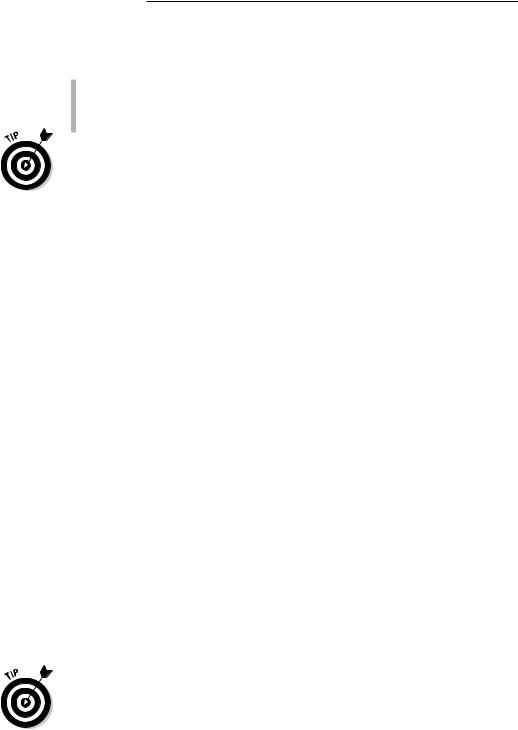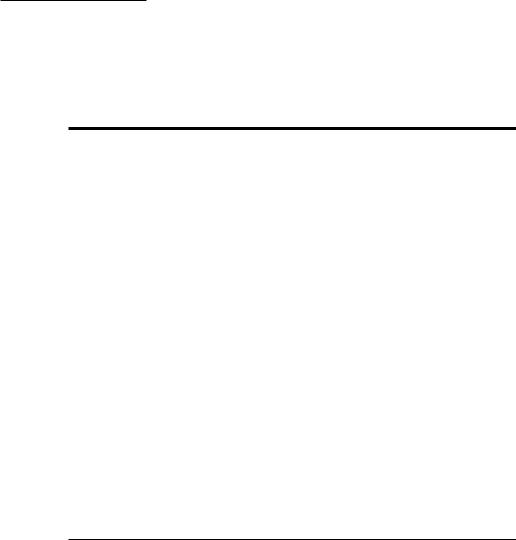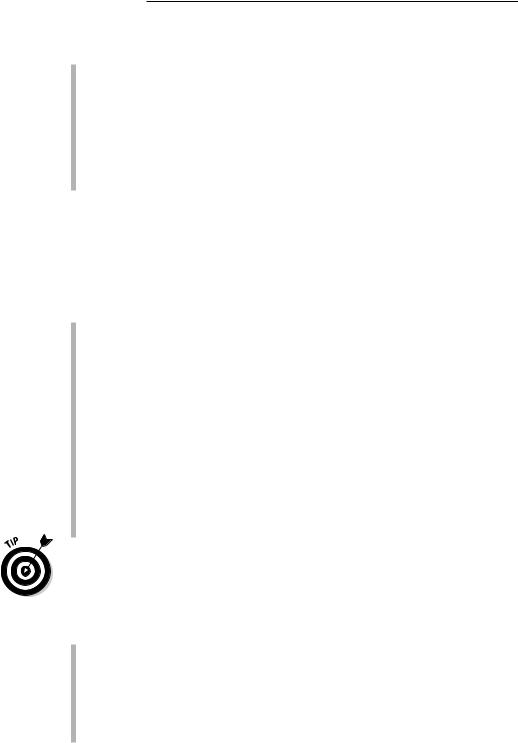
- •About the Authors
- •Dedication
- •Acknowledgments
- •Table of Contents
- •Introduction
- •About This Book
- •Conventions Used in This Book
- •Foolish Assumptions
- •How This Book Is Organized
- •Icons Used in This Book
- •Where to Go from Here
- •The French You’re Familiar With
- •Idioms and Popular Expressions
- •Key Parts of Speech
- •Cavorting with Verbs
- •Forming Sentences and Questions
- •The French Alphabet
- •Uttering Vowel and Consonant Sounds
- •Greetings: Formal and Friendly
- •Asking Questions to Get to Know People
- •Counting Your Lucky Stars: Numbers
- •Using the Calendar and Dates
- •Telling Time in French
- •Discussing Where You Live with the Verb “Habiter”
- •Discussing Daily Routine with Reflexive Verbs
- •Using Possessive Adjectives to Introduce Your Family Members
- •Basic Questions and Polite Expressions
- •Stating Your Preferences
- •Talking about Your Livelihood
- •Chatting about the Weather
- •Deciding to Keep in Touch
- •Getting Direction about Directions
- •Dining Out
- •Going to the Market
- •Going Shopping
- •Going Out with the Verb “Sortir”
- •Having Fun with the Verb “S’amuser”
- •Oh, the Places You’ll Go!
- •Making Plans with Friends
- •Making a Phone Call
- •Livin’ in the Past: Using the Past Tense
- •Playing Sports and Games
- •Going to the Beach
- •Setting Up Camp
- •Enjoying Quieter Pursuits
- •Where Do You Want to Go?
- •Getting Ready for Your Trip
- •Getting Current with Currency
- •Going to the Bank
- •Using Credit Cards and ATMs
- •Getting through the Airport
- •Navigating Buses, Trains, and Subways
- •Getting Around by Car
- •Finding Accommodations
- •Checking In to a Hotel
- •Checking Out of a Hotel
- •Getting Help Fast
- •Getting Medical Help
- •Handling Legal Matters
- •Label the Things in Your House
- •Write Your Shopping Lists in French
- •Listen to French Music
- •Watch French Movies
- •Tune in to TV5
- •Read French Publications
- •Take a Class
- •Join a French Association
- •Join an Online Chat or Pen Pal Forum
- •Using “Tu” When You Mean “Vous”
- •Using “Bonne nuit!” for Good-Bye
- •Using “Garçon” or “Porteur” to Address Service Staff
- •Saying “Je suis excité(e)” to Indicate Excitement
- •Saying “Je suis chaud(e)/froid(e)” to Say You’re Hot or Cold
- •Saying “Je suis plein/e” to Mean You’re Full
- •Using “de la glace” to Request Ice
- •Using “Je suis . . . ans” to Tell Your Age
- •Asking for Change with “J’ai besoin de change”
- •Using the Verb “Visiter” in Reference to People
- •“À mon avis”
- •“C’est pas vrai”
- •“Avec plaisir”
- •“C’est génial”
- •“À votre santé”
- •“À vos souhaits”
- •“Quelle horreur!”
- •“À bientôt”
- •“Passez-moi un coup de fil!”
- •“On y va!” or “Allons-y!”
- •“Je n’en sais rien”
- •“Je n’en reviens pas”
- •“Ça vaut la peine”
- •“C’est pas grave”
- •“N’importe”
- •“Tu cherches midi à 14h”
- •“Prenons un pot!”
- •Regular French Verbs
- •Auxiliary French Verbs
- •Track Listing
- •Customer Care
- •Index

16 |
Part I: Getting Started |
Idioms and Popular Expressions
French, like English, has many idioms (unusual ways of expressing feelings and ideas). You may find the meaning of these expressions puzzling if you try to translate them word for word.
These fixed forms of expression belong specifically to the language in question. If you walk up to a French person and say Il pleut des chats et des chiens (eel pluh dey shah ey dey shyaN) (It’s raining cats and dogs), he or she would question your sanity. On the other hand, you may find yourself wondering what a French speaker means when she says Il tombe des cordes (eel tohNb dey kohrd), whose literal translation is Ropes are falling, but it’s roughly equivalent to It’s raining cats and dogs.
Apart from those idioms, which take a long time to comprehend and belong specifically to a culture, every language has many expressions and phrases that, although they cannot be translated word for word, can easily be learned and used. Here are a few of the useful expressions you frequently hear
in French:
À la vôtre! (ah lah voh-truh!) (Cheers!)
À mon avis (ah mohN-nah-vee) (in my opinion)
À tes/vos souhaits! (ah tey/voh sweh!) (Bless you!/Gesundheit!)
Allez! Un petit effort! (ah-ley! uhN puh-tee-teh-fohr!) (Come on! Try a little!)
Bien sûr. (byaN sewr.) (Of course.)
Bon appétit! (bohN-nah-pey-tee!) (Enjoy your meal!)
Ça vaut la peine/le coup. (sah voh lah pehn/luh kooh.) (It’s worth it.)
D’accord. (dah-kohr.) (Okay.)
De rien. (duh ryaN.) (Don’t mention it.)
Jamais de la vie! (zhah-meh duh lah vee!) or Pas question! (pah kehs-tyohN!) (No way!)
Revenons à nos moutons. (ruh-vuh-nohN ah noh mooh-tohN.) (Let’s get back to the subject at hand.)
Tant mieux. (tahN myuh.) (So much the better.)
Tant pis. (tahN pee.) (Too bad.)
Tout à fait. (tooh-tah feh.) (Quite.)
Un coup d’oeil (uhN kooh duhy) (a glance, a quick look)
www.ATIBOOK.ir

Chapter 2
Laying the Foundation: Basic
French Grammar
In This Chapter
Getting familiar with nouns, articles, pronouns, adjectives, and adverbs
Understanding gender and agreement
Introducing regular and irregular verbs
Constructing simple sentences
In your native language, you instinctively know how to form sentences and ask questions that make sense. However, when learning a new language,
you need to learn that language’s grammar because it lays the foundation for communicating correctly and effectively. This chapter simplifies French grammar, introducing you to the parts of speech and telling you how to construct grammatically correct sentences and questions. As you read this material, you’ll be amazed to discover that learning basic French grammar is easy and completely painless. The key to success is to remain cool and patient. Little by little — and before you know it — you’ll be able to speak French.
Key Parts of Speech
Words are classified based on their part of speech — verbs, nouns, pronouns, adjectives, adverbs, prepositions, conjunctions, and interjections — depending on how they are used. In this section, we concentrate on a few key parts of speech you need to know in order to form and understand basic French sentences: nouns, articles, pronouns, adjectives, and adverbs. You can check out verbs in the later section “Cavorting with Verbs.”
www.ATIBOOK.ir

18 |
Part I: Getting Started |
Naming things with nouns
Nouns name things: people, objects, places, concepts, and so on. House is a noun. So is Mary or truth or Sandusky. There are a few key differences
between French and English nouns, however, as the next sections explain.
That whole gender thing
Unlike English nouns, all French nouns have a gender: They are either grammatically masculine or feminine. Knowing whether a noun is masculine or feminine is very important because it has an impact on the sentence construction. For example, if the noun is feminine, the articles and adjectives that modify that noun must also be feminine.
But how do you know whether a noun is masculine or feminine? Of course, if you are talking about the sex of a person or an animal, the gender is obvious. But if the noun is a thing or an idea, how do you determine its gender? For the most part, just look at the word’s ending. With a few exceptions, the ending of a noun is a rather good indication of its gender. Table 2-1 shows common masculine and feminine endings.
Table 2-1 Common Masculine and Feminine Noun Endings
Masculine |
Example |
Feminine |
Example |
Endings |
|
Endings |
|
–eur (uhr) |
l’auteur (loh-tuhr) |
–ade (ahd) |
la promenade (lah |
|
(author); le bonheur |
|
prohm-nahd) (walk); |
|
(luh boh-nuhr) |
|
la limonade (lah |
|
(happiness) |
|
lee-moh-nahd) |
|
|
|
(lemonade) |
–eau (oh) |
le chapeau (luh |
–ance/–ence |
la naissance (lah |
|
shah-poh) (hat); |
(ahNs) |
neh-sahNs) (birth); |
|
le manteau (luh |
|
la différence (lah |
|
mahN-toh) (coat) |
|
dee-fey-rahNs) |
|
|
|
(difference) |
–isme (eez- |
le capitalisme (luh |
–oire (wahr) |
la mémoire (lah |
muh) |
kah-pee-tah-leez- |
|
mey-mwahr) |
|
muh) (capitalism); |
|
(memory); la |
|
le féminisme (luh |
|
victoire (lah veek- |
|
fey-mee-neez-muh) |
|
twahr) (victory) |
|
(feminism) |
|
|
|
|
|
|
www.ATIBOOK.ir

|
|
|
Chapter 2: Laying the Foundation: Basic French Grammar |
19 |
|||
|
|
|
|||||
|
|
|
|
|
|
|
|
|
Masculine |
Example |
Feminine |
Example |
|
||
|
Endings |
|
Endings |
|
|
|
|
|
–ment |
l’appartement |
–sion/tion |
l’impression |
|
||
|
(mahN) |
(lah-pahr-tuh-mahN) |
(syohN) |
(laN-prey-syohN) |
|
||
|
|
|
(apartment); le |
|
(impression); la |
|
|
|
|
|
logement (luh |
|
condition (lah |
|
|
|
|
|
lohzh-mahN) |
|
kohN-dee-syohN) |
|
|
|
|
|
(lodging, place |
|
(condition) |
|
|
|
|
|
of residence) |
|
|
|
|
|
–ail (ahy) |
le travail (luh trah- |
–son (zohN) |
la saison (lah seh- |
|
||
|
|
|
vahy) (work); le |
|
zohN) (season); la |
|
|
|
|
|
détail (luh dey-tahy) |
|
maison (lah meh- |
|
|
|
|
|
(detail) |
|
zohN) (house) |
|
|
|
Final vowels |
le cinéma (luh |
–té, –ée |
la liberté (lah lee- |
|
||
|
other than –e |
see-ney-mah) |
(tey, ey) |
behr-tey) (freedom); |
|
||
|
|
|
(movies); le piano |
|
l’égalité (ley-gah- |
|
|
|
|
|
(luh pyah-noh) |
|
lee-tey) (equality); |
|
|
|
|
|
(piano); le genou |
|
l’idée (lee-dey) |
|
|
|
|
|
(luh zhuh-nooh) |
|
(idea); la pensée |
|
|
|
|
|
(knee) |
|
(lah pahN-sey) |
|
|
|
|
|
|
|
(thought) |
|
|
|
-al (ahl) |
le journal (luh |
–ie (ee) |
la boulangerie (lah |
|
||
|
|
|
zhoohr-nahl) (news- |
|
booh-lahN-zhree) |
|
|
|
|
|
paper); le festival |
|
(bakery); l’épicerie |
|
|
|
|
|
(luh feh-stee-vahl) |
|
(ley-pees-ree) |
|
|
|
|
|
(festival) |
|
(grocery store) |
|
|
In addition, certain occupations are always masculine in French, even though both men and women work in them. Some examples include
un professeur (uhN proh-feh-suhr) (teacher, professor)
un architecte (uhN-nahr-shee-tehkt) (architect)
un chef (uhN shehf) (chef)
un ingénieur (uhN-naN-zhey-nyuhr) (engineer)
un agent (uhN-nah-zhahN) (agent)
un médecin (uhN meyd-saN) (doctor)
un auteur (uhN-noh-tuhr) (author)
www.ATIBOOK.ir

20 |
Part I: Getting Started |
Similarly, some nouns are always feminine, even when they refer to a male.
Here they are:
une vedette (ewn veh-deht) (movie star)
une personne (ewn pehr-sohhn) (person)
une victime (ewn veek-teem) (victim)
If you come across a noun that does not follow any of these patterns, simply consult Appendix A in the back of this book or a French dictionary.
Making singular nouns plural
In French, as in English, nouns are either singular or plural. The French say they have a number. To make nouns plural, you simply add an s to most of them, just like in English. La maison (lah meh-zohN) (house) is singular while les maisons (ley meh-zohN) (houses) is plural.
However, if a noun ends in –ou, –eu, or –eau, you add an x instead of an s to make it plural: The singular le bureau (luh bew-roh) (office, desk) becomes the plural les bureaux (ley bew-roh) (offices, desks).
If a noun already ends in an –s, –z, or –x, you don’t add anything to it. In these instances, the article (and the context) makes clear that the noun is plural):
Singular |
Plural |
un fils (uhN fees) (son) |
des fils (dey fees) (sons) |
un nez (uhN ney) (nose) |
des nez (dey ney) (noses) |
un époux (uhN-ney-pooh) (spouse) |
des époux (dey-zey-pooh) (spouses) |
Keeping an eye on articles
Unlike English nouns, which don’t necessarily need articles (the words the, a, and an), French nouns are almost always preceded by articles. In English, for example, you say France, but in French, you say la France (lah frahNs)
(France). The same convention applies to plural nouns: mountains in English becomes les montagnes (ley mohN-tah-nyuh) (mountains) in French. Another difference between English and French articles is that French articles mark the gender and the number of nouns.
When you learn the gender of a noun, try to learn the article that goes with it. Instead of memorizing table (tah-bluh) (table), for example, memorize la table (lah tah-bluh) (the table) or une table (ewn tah-bluh) (a table). Instead of livre (lee-vruh) (book), think le livre (luh lee-vruh) (the book) or un livre (uhN leevruh) (a book).
www.ATIBOOK.ir

Chapter 2: Laying the Foundation: Basic French Grammar |
21 |
Table 2-2 lists the variations of definite, indefinite, and partitive articles in French. For details on how these articles are used, keep reading.
Table 2-2 Definite, Indefinite, and Partitive French Articles
Type of |
Masculine |
Feminine |
Preceding a Vowel |
Masculine and |
Article |
|
|
or Mute H |
Feminine Plural |
Definite |
le |
la |
l’ (see note) |
les |
(the) |
(luh) |
(lah) |
|
(ley) |
Indefinite |
un |
une |
un (uhN), |
des |
(a, an, some) |
(uhN) |
(ewn) |
une (ewn) |
(dey) |
Partitive |
du |
de la |
de l’ (see note) |
des |
(some, any) |
(dew) |
(duh lah) |
|
(dey) |
Note: L’ (ehl ah-pohs-trohf) means l apostrophe and de l’ (duh ehl ah-pohs- trohf) means de l apostrophe. These abbreviations are used when these articles are followed by a vowel or a mute h.)
Defining definite articles
The definite article refers to a specific noun and has only one form in English, even when used in the plural: the. In French, because nouns have a gender, the article has to take the gender of the noun as well as its number, singular or plural. Here are the definite articles in French:
le (luh) (the) — masculine definite article, singular
la (lah) (the) — feminine definite article, singular
l’ (ehl ah-pohs-trohf) (the) — masculine and feminine definite article, singular, used in front of nouns that start with a vowel or mute h.
les (ley) (the) — masculine and feminine definite article, plural
For example, the word nuage is masculine singular; therefore, you add a masculine, singular article in front of it: le nuage (luh new-ahzh) (the cloud). You follow the same pattern for a feminine singular noun: Simply add the feminine singular article la in front of maison, for example, and you have
la maison (lah meh-zohN) (the house). If the noun is plural, regardless of whether it’s masculine or feminine, the article is always les. For example, les nuages (ley new-ahzh) (the clouds) or les maisons (ley meh-zohN)
(the houses).
If a masculine or feminine noun begins with a vowel or a mute h (more on the mute h in Chapter 3), then you drop the e in le and the a in la and you add an apostrophe, l’. If nouns beginning with a vowel or a mute h are plural, just use les (ley). Here are some examples:
www.ATIBOOK.ir

22 |
Part I: Getting Started |
l’idée (f) (lee-dey) (idea)
les idées (ley-zee-dey) (ideas)
l’hôtel (m) (loh-tehl) (hotel)
les hôtels (ley-zoh-tehl) (hotels)
French also uses definite articles after verbs of preference, such as aimer (eh-mey) (to like, to love), détester (dey-tehs-tey) (to hate), and préférer (prey-fey-rey) (to prefer). (You can check verbs of preference out in Chapter 6). For example: J’aime le café (zhehm luh kah-fey) (I like coffee).
Using the indefinite article
When referring to undetermined objects, you use indefinite articles, equivalent to the English words a and an. In French, the indefinite articles are
un (uhN) (a, an) — masculine indefinite article, singular
une (ewn) (a, an) — feminine indefinite article, singular
des (dey) (some, any) — masculine and feminine indefinite article, plural
You use French indefinite articles the same way you use English indefinite articles. Check out the following examples:
Paris est une grande ville. (pah-ree eh-tewn grahNd veel.) (Paris is a big city.)
Je voudrais un café. (zhuh vooh-dreh-zuhN kah-fey.) (I would like a coffee.)
Il y a des maisons dans la rue. (eel ee ah dey meh-zohN dahN lah rew.) (There are houses on the street.)
Choosing the partitive
The French language has a specific article that refers to a part of something as opposed to the whole. You can sometimes translate this article as some or any, but it is frequently omitted in English.
As you may guess, the article has a masculine form, du (dew); a feminine form, de la (duh lah); and a plural form, des (dey). There is also a singular form when the noun that follows starts with a vowel or a mute h, de l’ (duh ehl ah-pohs-trohf). Here are a few examples:
Je voudrais du pain et du fromage. (zhuh vooh-dreh dew paN ey dew froh-mahzh.) (I would like [some] bread and [some] cheese.)
Si tu as soif, bois de l’eau! (see tew ah swahf, bwah duh loh!) (If you are thirsty, drink [some] water!)
Il mange souvent de la salade. (eel mahNzh sooh-vahN duh lah sahlahd.) (He often eats [some] salad.)
www.ATIBOOK.ir

Chapter 2: Laying the Foundation: Basic French Grammar |
23 |
Meeting subject pronouns face to face
Pronouns replace nouns, enabling you to avoid clumsy repetition when you write or speak. In French, pronouns change, depending on their role (subject, direct object, indirect object, or to show possession) in a sentence. Fortunately, you don’t need to worry about all those different forms at this point. Instead, this section focuses on French subject pronouns, those that function as subjects. (The other pronouns are covered in various chapters throughout the book.)
In a sentence, the subject indicates who or what is performing the action. In the sentence “John plays tennis,” John is the subject. You can replace John with the pronoun he, and the sentence becomes “He plays tennis.” In this case, the pronoun he is the subject. Here are the French subject pronouns with their English translations:
Singular
je (zhuh) (I)
tu (tew) (you)
il/elle/on (eel/ehl/ohN) (he/she/it, one)
Plural
nous (nooh) (we)
vous (vooh) (you)
ils/elles (eel/ehl) (they)
Taking a closer look at “je”
Unlike the English I, je is not capitalized in French, unless it begins the sentence. Also, if the verb that follows je begins with a vowel or a mute h (head to Chapter 3 for more on the mute h), the –e is dropped and an apostrophe added. This doesn’t happen with any other subject pronoun. Here’s an example:
J’aime le français. (zhehm luh frahN-seh.) (I like French.)
More on “il,” “elle,” “ils,” and “elles”
As mentioned previously, French nouns are either feminine or masculine. The same is true of French pronouns. Therefore, il refers not only to a person, meaning he, but also to a masculine singular object, meaning it. For example, il siffle (eel see-fluh) could mean he is whistling or it is whistling, depending on the context of the sentence. The same thing applies to elle. Elle est belle (ehl eh behl) could mean she is beautiful or it is beautiful. Of course, ils and elles,
the masculine and feminine third person plurals, have only one meaning, they, regardless of whether they refer to people or things.
It’s “you,” you know: The tu/vous issue
Both tu and vous mean you, but you need to be aware of a fundamental difference between them. Tu is always singular, whereas vous can be singular or plural.
www.ATIBOOK.ir

24 |
Part I: Getting Started |
Vous is both singular and plural, yet even when it refers to one person, you always conjugate the verb in the plural. So start practicing your greetings using vous and the corresponding verb form ending –ez (except for three irregular verbs), whether you’re addressing one person or more.
How you address someone in French depends on how well you know them. If the person is a family member, a peer, or a child, you use tu, which is an informal way of speaking to someone. You need to use the more polite and respectful form of the English you, vous, in these situations:
When you meet someone for the first time (unless that person is a child)
When you’re talking to someone older than yourself
When you’re talking with someone with authority, like your teacher or your supervisor
When you are referring to two or more people
Go to Chapter 3 for more information about using tu and vous.
In France, using tu to address a stranger or a new acquaintance would sound strange at best and impolite at worst. However, if you go to Quebec, you may soon discover that the familiar tu is much more liberally used at all times.
Using “on” for all
On, a very versatile subject pronoun, has several meanings: one, we, they, and people. The sentence On parle français au Québec (ohN pahrl frahN-seh oh key-behk), for example, can mean One speaks French in Quebec or We/ they/people speak French in Quebec.
On can also be used when you want to repeat something that you heard without revealing your source: On m’a dit qu’on vous a renvoyé. (ohN mah dee kohN vooh-zah rahN-vwah-ey.) (Someone told me that you got fired.)
Pretty handy pronoun, right? Remember that whether on refers to a singular or a plural subject, its verb conjugation is always third person singular. (See the verb conjugations later on in this chapter)
Getting descriptive with adjectives
Adjectives describe nouns. Because French nouns have both gender and number, any adjectives have to match the nouns they modify in gender and number.
www.ATIBOOK.ir

Chapter 2: Laying the Foundation: Basic French Grammar |
25 |
Changing adjective endings to specify gender
You can change the ending of an adjective so that it agrees in gender and number with the noun. Table 2-3 shows the masculine and feminine singular and plural forms, as well as examples using these endings.
Table 2-3 |
Endings of French Adjectives |
|
|
Masc., Sing |
Fem. Sing. |
Masc. Plural |
Fem. Plural |
–e: calme |
–e: calme |
–es: calmes |
–es: calmes |
(kahlm) (calm) |
(kahlm) |
(kahlm) |
(kahlm) |
–é: fatigué (fah- |
–ée: fatiguée |
–és: fatigués |
–ées: fatiguées |
tee-gey) (tired) |
(fah-tee-gey) |
(fah-tee-gey) |
(fah-tee-gey) |
–consonant: |
–consonant + e: |
–consonant + s: |
–consonant + es: |
grand (grahN) |
grande (grahNd) |
grands (grahN) |
grandes (grahNd) |
(big, tall) |
|
|
|
–eux: heureux |
–euse: heureuse |
–eux: heureux |
–euses: heu- |
(uh-ruh) (happy) |
(uh-ruhz) |
(uh-ruh) |
reuses (uh-ruhz ) |
–eur: travailleur |
–euse: tra- |
–eurs: tra- |
–euses: trav- |
(trah-vah-yuhr) |
vailleuse (trah- |
vailleurs (trah- |
ailleuses (trah- |
(hard working) |
vah-yuhz) |
vah-yuhr) |
vah-yuhz) |
–teur: conser- |
–trice: conser- |
–teurs: conser- |
–trices: conser- |
vateur (kohN- |
vatrice (kohN- |
vateurs (kohN- |
vatrices (kohN- |
sehr-vah-tuhr) |
sehr-vah-trees) |
sehr-vah-tuhr) |
sehr-vah-trees) |
(conservative) |
|
|
|
–f: sportif |
–ve: sportive |
–fs: sportifs |
–ves: sportives |
(spohr-teef) |
(spohr-teev) |
(spohr-teef) |
(spohr-teev) |
(athletic) |
|
|
|
–ien: canadien |
–ienne: ca- |
(kah-nah-dyaN) |
nadienne (kah- |
(Canadian) |
nah-dyehn) |
–iens: canadiens (kah- nah-dyaN)
–iennes: canadiennes (kah- nah-dyehn)
–on: bon (bohN) |
–onne: bonne |
–ons: bons |
–onnes: bonnes |
(good) |
(bohhn) |
(bohN) |
(bohhn) |
–er: fier (fyehr) |
–ère: fière |
–ers: fiers |
–ères: fières |
(proud) |
(fyehr) |
(fyehr) |
(fyehr) |
www.ATIBOOK.ir

26 |
Part I: Getting Started |
A few adjectives have very irregular forms in the feminine singular:
beau/belle (boh/behl) (beautiful): un beau garçon (uhN boh gahr-sohN) (a beautiful [handsome] boy) and une belle fille (ewn behl feey)
(a beautiful girl)
nouveau/nouvelle (nooh-voh/nooh-vehl) (new): un nouveau manteau
(uhN nooh-voh mahN-toh) (a new coat) and une nouvelle robe (ewn nooh-vehl rohhb) (a new dress)
vieux/vieille (vyuh/vyehy) (old): un vieux bureau (uhN vyuh bew-roh) (an old desk) and une vieille maison (ewn vyehy meh-zohN) (an old house)
Putting the adjective in the right place
Most French adjectives are placed after the noun they describe, which is the opposite from English. Whereas in English you say an interesting trip, for example, in French you say un voyage intéressant (uhN voh-yahzh aN-tey- reh-sahN). However, this rule changes when the adjectives relate to any of the following. In these cases, the adjective goes in front of the noun:
Beauty: Adjectives in this category include beau/belle (boh/behl) (beautiful) and joli/jolie (zhoh-lee) (pretty)
Age: The category includes words like jeune (zhuhn) (young), vieux/vieille (vyuh/vyehy) (old), and nouveau/nouvelle (nooh-voh/nooh-vehl) (new).
Numbers: Words in this group include premier/première (pruh-myey/ pruh-myehr) (first, premiere), dernier/dernière (dehr-nyey/dehr-nyehr) (last), deux (duh) (two), trois (trwah) (three), and so forth.
Goodness (or lack of it): Words like bon/bonne (bohN/bohhn) (good), mauvais/mauvaise (moh-veh/moh-vehz) (bad), and gentil/gentille
(zhahN-tee/zhahN-teey) (nice) are in this group.
Size: This category includes words like grand/grande (grahN/grahNd) (big, tall), petit/petite (puh-tee/puh-teet) (small, little), and gros/grosse (groh/grohs) (large, fat, thick).
To help you remember that these categories of words precede the noun, think B-A-N-G-S: Beauty, Age, Numbers, Goodness, Size).
Some adjectives are a little tricky because they can change meaning according to whether they are placed before or after the noun. Check out the following list:
ancien/ancienne (ahN-syaN/ahN-syehn): Before the noun, it means former; after the noun it means ancient or old.
cher/chère (shehr/shehr): Before the noun, it means dear; after the noun, it means expensive.
pauvre (poh-vruh): Before the noun, it means unfortunate, and after, it means penniless.
www.ATIBOOK.ir

Chapter 2: Laying the Foundation: Basic French Grammar |
27 |
propre (proh-pruh): Before the noun, it means own; after the noun, it means clean.
Here’s a way to remember the different meanings of these adjectives: When placed before the noun, the meaning is figurative. When placed after the noun, the meaning is literal. Here are some examples:
un ancien collègue (uhN-nahN-syaN koh-lehg) (a former colleague) versus un bâtiment ancien (uhN bah-tee-mahN ahN-syaN) (an old building)
un pauvre garçon (uhN poh-vruh gahr-sohN) (an unfortunate boy) versus un enfant pauvre (uhN-nahN-fahN poh-vruh) (a poor or impoverished child)
Getting creative with adverbs
An adverb is a word that modifies (describes) a verb, an adjective, or another adverb. In English, many adverbs end with –ly: quickly, nervously, slowly, and so on. In French, most adverbs end in –ment, and they usually follow the verb. Here are the rules:
To the feminine form of an adjective, add –ment: lente (lahNt) (slow) becomes lentement (lahNt-mahN) (slowly), and active (ahk-teev) (active) becomes activement (ack-teev-mahN) (actively).
To the masculine form of an adjective that ends in a vowel, add –ment: vrai (vreh) (true) becomes vraiment (vreh-mahN) (truly, really), and absolu (ahb-soh-lew) (absolute) becomes absolument (ahb-soh-lew- mahN) (absolutely).
To the masculine form of an adjective that ends in –ent or –ant, drop the nt and add –mment: constant (kohN-stahN) (constant) becomes
constamment (kohN-stahN-mahN) (constantly), and évident (ey-vee-dahN) (evident) becomes évidemment (ey-vee-dah-mahN) (evidently, obviously).
The adverbial forms of good and bad are irregular in French. The adjective good — bon (bohN) — becomes the adverb bien (byaN) (well) and mauvais (moh-veh) (bad) becomes mal (mahl) (badly).
Most adverbs in French come right after the verb:
Parlez lentement, s’il vous plaît. (pahr-ley lahNt-mahN, seel-vooh-pleh.) (Speak slowly, please.)
Les petits oiseaux chantent joyeusement. (ley puh-tee-zwah-zoh shahNt zhwah-yuhz-mahN.) (The little birds sing happily.)
www.ATIBOOK.ir
